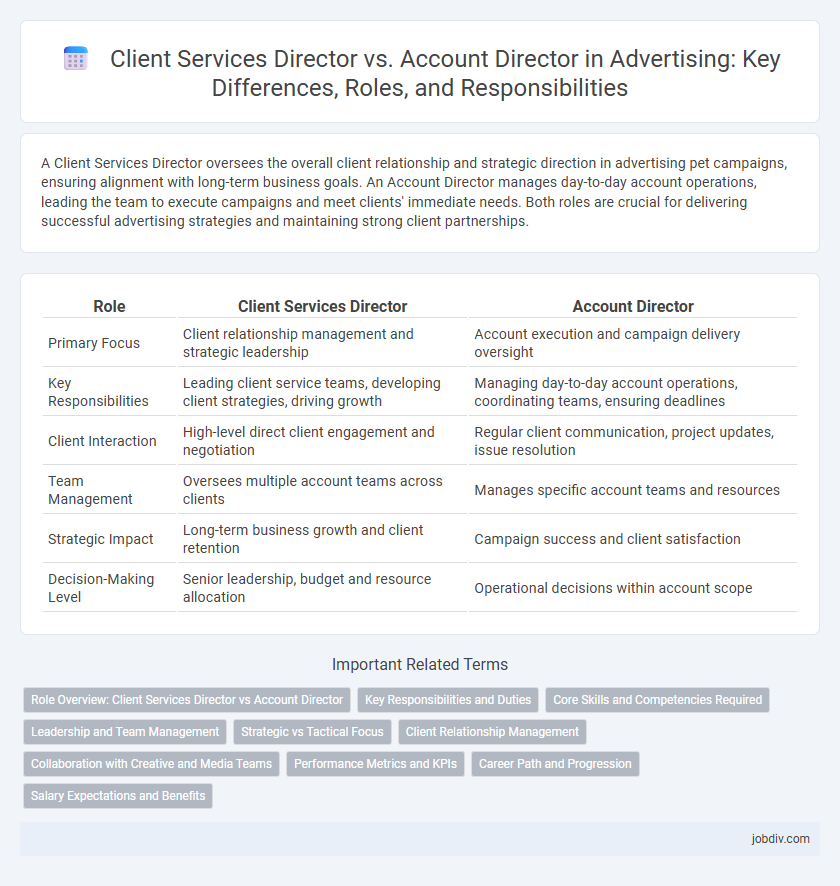A Client Services Director oversees the overall client relationship and strategic direction in advertising pet campaigns, ensuring alignment with long-term business goals. An Account Director manages day-to-day account operations, leading the team to execute campaigns and meet clients' immediate needs. Both roles are crucial for delivering successful advertising strategies and maintaining strong client partnerships.
Table of Comparison
| Role | Client Services Director | Account Director |
|---|---|---|
| Primary Focus | Client relationship management and strategic leadership | Account execution and campaign delivery oversight |
| Key Responsibilities | Leading client service teams, developing client strategies, driving growth | Managing day-to-day account operations, coordinating teams, ensuring deadlines |
| Client Interaction | High-level direct client engagement and negotiation | Regular client communication, project updates, issue resolution |
| Team Management | Oversees multiple account teams across clients | Manages specific account teams and resources |
| Strategic Impact | Long-term business growth and client retention | Campaign success and client satisfaction |
| Decision-Making Level | Senior leadership, budget and resource allocation | Operational decisions within account scope |
Role Overview: Client Services Director vs Account Director
Client Services Directors oversee the strategic management of client relationships, focusing on long-term growth and cross-functional team leadership within advertising agencies. Account Directors concentrate on the day-to-day management of client accounts, ensuring campaign execution aligns with client objectives and budgets. The Client Services Director drives high-level business development and client retention, while the Account Director handles operational client communication and project delivery.
Key Responsibilities and Duties
A Client Services Director oversees the strategic management of client relationships, ensuring alignment between client goals and agency capabilities while driving business growth. An Account Director primarily manages day-to-day client accounts, coordinating project execution and maintaining communication between clients and internal teams. Both roles demand strong leadership, but the Client Services Director focuses more on high-level strategy and partnership development, whereas the Account Director emphasizes operational delivery and client satisfaction.
Core Skills and Competencies Required
Client Services Directors excel in relationship management, strategic planning, and cross-functional team leadership, ensuring client satisfaction and long-term partnership growth. Account Directors emphasize project execution, budgeting, and campaign delivery, with strong skills in client communication, negotiation, and performance analysis. Both roles require deep industry knowledge, exceptional problem-solving abilities, and proficiency in data-driven decision-making to optimize advertising outcomes.
Leadership and Team Management
Client Services Directors oversee overall client relationship strategies, ensuring alignment with business objectives while inspiring cross-functional teams to achieve performance targets. Account Directors focus on managing specific accounts with hands-on leadership, guiding account teams to deliver creative solutions and drive client satisfaction. Effective leadership in both roles requires strong communication, strategic decision-making, and the ability to foster collaboration across departments.
Strategic vs Tactical Focus
Client Services Directors concentrate on strategic initiatives by shaping long-term marketing goals, overseeing integrated campaign development, and aligning advertising strategies with overall business objectives. Account Directors focus on tactical execution, managing daily client interactions, coordinating project deliverables, and ensuring timely campaign implementation. The strategic role drives innovation and brand positioning while the tactical role ensures operational efficiency and client satisfaction.
Client Relationship Management
Client Services Directors oversee strategic client relationships, ensuring long-term partnership growth and satisfaction through tailored service solutions. Account Directors manage day-to-day client interactions, focusing on campaign execution, budget oversight, and meeting project deliverables. Both roles collaborate closely to enhance client retention and deliver impactful advertising outcomes aligned with business objectives.
Collaboration with Creative and Media Teams
The Client Services Director drives strategic alignment between client objectives and creative output, ensuring seamless collaboration with both creative and media teams to optimize campaign effectiveness. The Account Director manages day-to-day client communications and project execution, coordinating closely with creative and media departments to maintain workflow efficiency and meet deadlines. Both roles require strong interpersonal skills to bridge client needs with creative innovation and media strategy, fostering integrated advertising solutions.
Performance Metrics and KPIs
A Client Services Director typically oversees broader client relationship strategies, focusing on overall client satisfaction scores, retention rates, and long-term revenue growth as key performance indicators. In contrast, an Account Director emphasizes tactical execution and campaign performance metrics, such as ROI, conversion rates, and media spend efficiency to drive project-specific success. Both roles prioritize KPIs that align with client objectives, but the Client Services Director manages comprehensive service delivery while the Account Director concentrates on day-to-day account management and deliverable outcomes.
Career Path and Progression
Client Services Directors oversee the entire client relationship strategy, focusing on long-term growth and cross-departmental collaboration, often advancing from Account Directors who manage day-to-day client communications and project execution. Career progression typically moves from Account Executive to Account Director, then to Client Services Director, requiring increased leadership skills and strategic vision. Experience in managing larger teams and multi-channel campaigns is essential for promotion to Client Services Director within advertising agencies.
Salary Expectations and Benefits
Client Services Directors typically earn higher salaries than Account Directors, with averages ranging from $120,000 to $150,000 annually compared to $90,000 to $120,000 for Account Directors. Benefits for Client Services Directors often include performance bonuses, stock options, and executive health plans, reflecting their strategic role in managing client relationships. Account Directors receive comprehensive benefits packages as well, but these usually focus more on performance incentives and professional development opportunities.
Client Services Director vs Account Director Infographic

 jobdiv.com
jobdiv.com